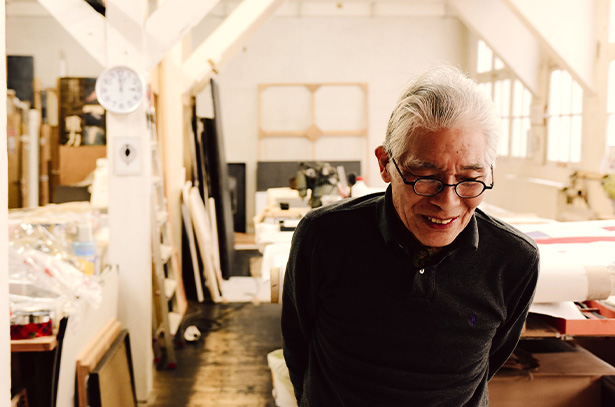
Takesada Matsutani
19 March - 21 May 2016
Zürich
Beginning 19 March 2016, Hauser & Wirth will present the gallery’s first Zurich exhibition devoted to internationally-admired Osaka-born, Paris-based artist Takesada Matsutani. Over a five-decade career that began with his participation in the Gutai Art Association and evolved to express the tangled complexities of a life lived between France and Japan, Matsutani has developed a unique visual language of form and materials. His work plays with notions of time and the movement of our bodies through it. Engaging themes of the eternal and the infinite, and echoing the endless cycles of life and death, Matsutani merges material, hue, and movement to arrive at an art about the present moment and the reverberating forces and unceasing currents from which life itself flows. Highlighting the artist’s practice in Paris at the beginning of the 1970s, ‘Takesada Matsutani’ at Hauser & Wirth will present never before seen paintings from the artist’s early career. Organised with Olivier Renaud-Clément, the exhibition will remain on view at the gallery until 21 May 2016. Takesada Matsutani was a recognised member of Japan’s avant-garde Gutai Art Association (1954 – 1972), exhibiting in group shows with them beginning in 1960 and having a solo presentation at the Gutai Pinacotheca in Osaka in 1963. Developing an aesthetic in his formative years through radical experimentations with vinyl glue, the young artist impregnated the surface of his canvases with bulbous elements, using his own breath to create swollen and ruptured forms evocative of flesh and wounds. For his ability to elicit the sensual tactility of his materials and create viscerally profound new forms, Matsutani was awarded first prize at the First Mainichi Art Competition in 1966 and received a six-month scholarship from the French government to study abroad. This journey to France would transform his career. While the teachings and ethos of Gutai have exerted an enduring influence upon the artist, nearly 50 years later Matsutani still calls Paris his home. Visitors will encounter Matsutani’s bold, colourful paintings from the early 1970s, a radical body of work that reveals the evolution of his earlier formative notions. Soon after moving to Paris and beginning work at renowned engraver Stanley William Hayter’s Atelier 17, Matsutani devoted himself to the techniques of etching, printmaking, and silkscreen. Hayter’s workshop was a centre for creative exchange and collaboration, both in Paris and New York, and exerted profound influence upon such artists as Louise Bourgeois, Salvador Dalí, Marcel Duchamp, Max Ernst and Joan Miró. Through the prowess of Atelier 17, American Abstraction and the New York School collided and mingled with the European avant garde – for Matsutani, Atelier 17 introduced new forms of artistic experimentation. Influenced by the theories and history of ‘the image’ in Western culture, and especially by American Minimalism and the Hard Edge paintings of Ellsworth Kelly, he began to conceive new compositions, re-arranging and testing the limits of pictorial space. Transforming the same organic and biomorphic forms he first developed in glue, the progression from ‘Le Développement-A1-69’ (1969) to ‘Two Objects’ (1970) displays the transformation of the artist’s pooling, curvaceous forms into flat geometric planes of colour on canvas. Many of the works on canvas from the early 1970s on display at Hauser & Wirth Zürich have never been exhibited in public before. Beyond the two-dimensional re-imagination of the artist’s previous forms created in glue, these canvases bring a vibrant inventive juxtaposition of colour. His use of shape grows more complex with the works of 1972, such as ‘Harugakita’, and breaks into a dynamic intermingling of forms in ‘Sky-B’ and ‘Propagation-72’. A truly singular period in the artist’s career, the early 1970s timeframe of the current show highlights Matsutani’s committed exploration of the flattening of shapes, through a frank use of strong colours in oil on canvas.
Selected images

Work-C
1971

Both Sides
1971

A Spot
1971

Propagation-F
1971

Both Sides-2
1971

Sky-B
1972

Suggestion-Red
1971

Untitled
1971

Box of Hope
1972

Work-B
1971

Arrow
1971

Harugakita
1972

Work A
1971

Propagation-72
1972
Installation views


Related Content
About the Artist

Takesada Matsutani
From the early 1960s until the 1970s Matsutani was a key member of the ‘second generation’ of the influential post war Japanese art collective, the Gutai Art Association. Over five decades Matsutani has developed a unique visual language of form and materials. As part of the Gutai group, Matsutani experimented with vinyl glue, using fans and his own breath to manipulate the substance, creating bulbous and sensuous forms reminiscent of human curves and features.
In 1966, Matsutani received a grant from the French government after winning first prize in the 1st Mainichi Art Competition and subsequently moved to Paris where he began working at Stanley William Hayter's renowned printmaking studio, Atelier 17. During the four years he worked at the studio, he learnt French, married and established his base in Paris. Working alongside Hayter opened Matsutani up to a new form of artistic experimentation and offered him a newfound confidence. Matsutani began to rethink his practice and a new elemental aesthetic language began to emerge that was both controlled and organic.
After the Gutai group disbanded in 1972, Matsutani eased into a radical yet consistent new body of work, informed by his experience at Atelier 17. Faithful to his Gutai roots, he strove to identify and convey the essential character of vinyl glue with graphite, that were to become his signature materials. Matsutani began creating vast expanses of metallic black graphite on mural-size sheets of paper built up with painstaking individual strokes. This ritualized manner presents a time-based record of his gestures, while reminiscent of his artistic beginnings in Japan, it has been translated into an artistic language that is uniquely his own.
Current Exhibitions
1 / 12














